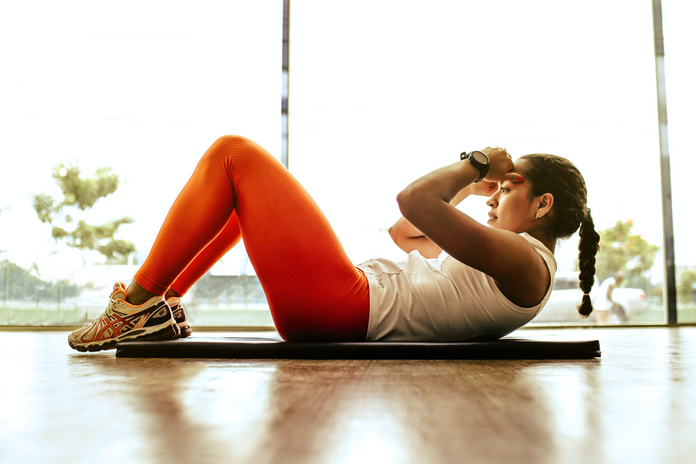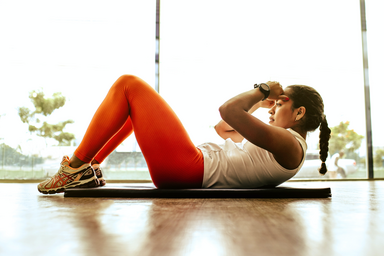Moving your workout from the gym to your living room poses a few challenges. If you’re used to spending your active time with high-end equipment and a trainer or instructor, it’s easy to feel tempted to repeat your same routine or class at home.
However, without the proper supervision or machinery, certain exercises that often feel fine in the gym can become dangerous when you’re alone in your own apartment. Luckily, there are plenty of safe workouts you can do at home that will still help you break a sweat — without pulling a muscle.
These tips are especially important if you’re dealing with sensitivity or injuries anywhere. Working out is supposed to make you feel strong and healthy, not damage your joints and leave you feeling like a limp noodle. The most common ailments are back, knee and shoulder-related. If you find an exercise is hurting you in one of those spots a little too much for your liking, it’s always best to stop right away and find an alternative no matter where you are.
Obviously, if you are an instructor, elite athlete or highly experienced practitioner with an understanding of proper form and an independent comfort level, you may be able to take on higher-intensity exercises at home. But for the average student who wants to stay in shape at home, here are a few moves to avoid — and what to do instead.
- Working Out Without a Warm-Up
-
When done properly, at-home exercise can raise your energy levels and improve your mood — but if you jump in too soon without warming up, you exchange exercise’s benefits for potential risks.
While this one might sound like a given, it’s vital to have a solid, well-rounded warmup. Starting your workout without warming up can cause injury or leave you underperforming in your workout.
Instead, try this: Take at least 10 minutes before and after each workout to warm up and cool down.
- Ramping the Intensity Too High for Your Fitness Level
-
This rule applies to just about every person who does home exercises. It can be tempting to add way more weight or reps than you’re used to or go for another mile on your run just because. However, more often than not, doing too much can leave you sore and achy, and can even lead to injury.
Instead, try this: Set your ultimate goal and plan small steps to work your way up to it gradually and responsibly.
- Romanian Deadlifts
-
Romanian deadlifts involve lifting a heavy barbell from the ground. Without proper technique and sometimes a second set of eyes, deadlifts can lead to serious back injuries. Romanian deadlifts particularly can pose a threat to your lower back, hamstrings and even your knees.
Instead, try this: Do deep lunges to work the glutes and hamstrings. If this feels too easy, you can add weight by holding dumbbells in your hands.
- Kettlebell Swings
-
Most people either love kettlebell swings or hate them. Regardless of your relationship to these somewhat controversial gym buddies, the potential for injury when doing kettlebell swings is higher than most home workouts.
Many fitness professionals even recommend avoiding kettlebell swings altogether. With the risk of back and shoulder injury, it’s just not worth it.
Instead, try this: Perform some hip thrusts, which work the posterior chain of the spine without the same risk to your shoulders and back. If you want, you can even rest weights on your hips. Just make sure to tuck the tailbone under while you do this to protect your lower back.
- Backward or Twisting Medicine Ball Throws
-
Like so many of the other items on this list, twisting medicine ball throws are historically not the kindest for your back. While twisting and throwing with weight may leave you with shredded obliques, they shouldn’t come at the expense of damaging your spine.
Instead, try this: A few sets of bicycle crunches provide the same abdominal engagement and oblique work, and medicine ball squats work the legs.
- Inversions
-
For all the yogis out there looking to do handstands or headstands, reconsider before tossing yourself against the nearest wall. While working your way up to a regular inversion practice can be beneficial and rewarding, it’s also crucial to build up the strength and balance necessary to invert properly.
Not only is there a risk of injury to the neck, back and shoulders, but there is always a risk of falling.
Instead, try this: Get a solid foundation of inversion prep. Yoga poses like L stand and dolphin are great at helping you build strength and balance. When you begin to feel more comfortable and stable, inverting might be a better idea.
However, if you have existing neck, back or shoulder injuries that inversions might strain further, it might be best to hold off. Wait until you’re in the presence of a trusted yoga teacher or fitness instructor who can spot you or give you closer instruction.
Exercise at home for women can be tricky to navigate. But when you’re aware of the worst workouts to do — and you know how to replace them with safer but equally challenging alternatives — you can get moving and feel fit without needing to leave your living room.


